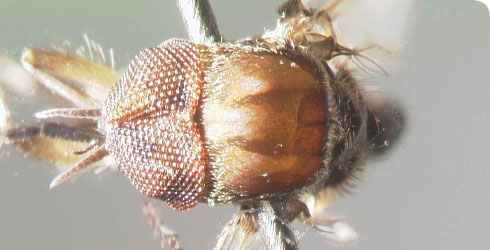Male Simulium rubrithorax
General body colour mottled orange-brown and black. Body length 3.7-4.4mm (mean = 4.0mm, s.d. = 0.32, n = 4); wing length 2.6-3.8mm (mean = 3.4mm, s.d. = 0.4, n = 9); wing width 1.3-1.9mm (mean = 1.6mm, s.d. = 0.2, n = 9).
Head
Holoptic with upper eye facets red and lower eye facets dark red (appearing black in dried specimens). Rest of head coloration as in female.
Thorax
- Scutum orange-brown with some black areas (sometimes black) and silver pruinosity; numerous recumbent, golden hairs.
- Scutum with median, indistinct, white cuna and 1+1 sub-median, indistinct, white cunae on anterior half and 1+1 light brown, sub-median vittae in median half diverging posteriorly with anterior illumination.
- Lateral margins and posterior quarter of scutum silver pruinose. Scutum with 1+1 sub-median, narrow, silver vittae in middle third of scutum diverging posteriorly with posterior lighting.
- Black areas around humeri and central third of scutum. Humeri orange-brown Coloration and setation of paranotal folds, pleural region, scutellum and postnotum as in female.
- Subcostal wing vein as female.
- Basal quarter of Radius bare, remainder with irregular row of 22-25 stout setae interspersed with several fine setae.
- Leg and halteres coloration as in female.
Abdomen
- Tergites mainly velvet black, slightly mottled, genitalia light brown. Tergite I mottled yellow and black with fringe of long, pale hairs. Silver ornamentation as follows: tergite II with anterior border silver pruinose and 1+1 large, silver, pruinose spots occupying five sixths of lateral area; tergites VI, VII with 1+1 relatively large, distinct, lateral, pruinose spots; remaining tergites with 1+1 small, pruinose, antero-lateral spots.
- Sternites pale brown with poorly developed sternal plates.
- Gonocoxite rectangular, one and a half times as wide as long; gonostyle elongate, over twice as long as wide, and slightly 'S' shaped with weakly developed, sub-terminal spine.
- Ventral plate well developed with large, wide, median anterior process densely covered with long setae and well developed keel; lateral shoulders absent and basal arms well developed and almost parallel; median sclerite pyriform with apical incision.
- Paramere with large basal process and two distinct clusters of stout spines, sub-median with about 20 spines, lateral with slightly fewer spines and extending to basal process.
